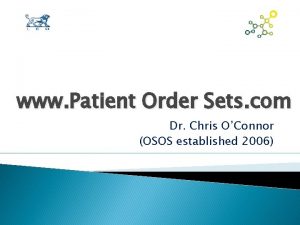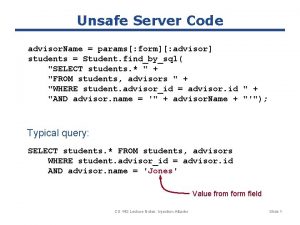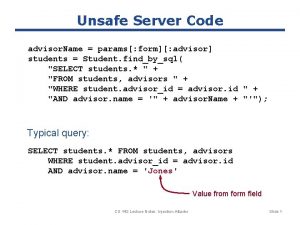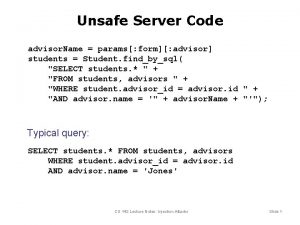Dr Martin Connor Special Advisor Special Delivery Unit














































- Slides: 46

Dr. Martin Connor Special Advisor Special Delivery Unit, DH

HMI Briefing Martin Connor 3 rd October 2011

SDU so far 1) Established as management team at start September 2) Delivery through associated partners: 1) Clinical Programmes 2) ISD 3) CPCP 4) Quality and Patient Safety 5) NTPF 3) Ministerial remit to resolve problems 4) Supporting HSE performance management through existing processes: ISD and RDOs

The strategy cannot be about marginal adjustment – it has to be about system transformation

Values


OVERVIEW OF SDU ACCESS STRATEGY

New performance management arrangements

PERFORMANCE IMPROVEMENT We hold leaders personally accountable for performance against KPIs We clarify sanctions and incentives (an essential part of the leadership challenge) WHEEL Escalation Numeric Objectives Intervention Monitoring: Frequency, Quality, Lag We start here with simplified, clearer targets that better reflect the patient journey We establish systematic, comprehensive and high frequency weekly monitoring systems

Definition OUTLINE OF NEW PERFORMANCE REGIME Persistent performance issues or no confidence standards will be delivered Significance Special measures Expectation of change in hospital leadership Closer monitoring, elevated concern On trajectory or high confidence standards will be delivered Light touch monitoring, hospital entitled to priority for strategic developments y Some performance issues or medium confidence standards will be dlievered tonom ed Au Very high frequency monitoring, high concern Earn Ongoing performance issues or low confidence standards will be delivered This scheme requires the introduction of a hospital-level scorecard with hard targets…

Quality, access, finance: The basis of the new scorecard

QUALITY Safe, high quality, patient centred service ACCESS FINANCIAL BALANCE

3 YEAR TARGETS

PACE OF CHANGE – ACCESS DELIVERY ED December 2012 December 2013 75% 85% December 2014 95% (No pt waiting > 9 hrs) IPDC 9 mths Definite 6 mths 21 weeks Indicative OP OP ? DIAG ? ? Maximum waiting time targets ?

UNSCHEDULED CARE

SYSTEMATIC ANALYSIS



The Plan July Aug Sept Nov Oct Dec Jan ED ICT prepares 2012 shift to total journey times ISA-based capacity planning for Winter Weekly performance meetings commence Discharge/ bed mgt networks established Local capacity plans signed off Escalation plans signed off Daily pressure monitoring

Capacity and information completeness

CAPACITY PLANNING • The capacity available each day through December and January, including medical beds and clinician rosters, discharge teams and bed managers • The availability of diagnostic support through December and January • Primary care and GP availability within the area over the Christmas and New Year period • Plans to provide extra capacity in ED to handle the potential for increased attendances in those areas where this has been a feature of demand in the past • Planned increases in capacity in early January to manage any increases in patient flow that occur • Home help and community service availability across the holiday period • Availability of services to support discharge across the holiday period • The availability of step-down or intermediate care beds within the locality • The availability of outpatient slots to manage patients who can be safely sent home to return for 24 or 48 hour review • The profile of elective activity to ensure that waiting time targets are met in a way that is mindful of the need to maintain unscheduled care responsiveness

Capacity & Risk Assessment

Capacity Planning - Responsibilities

Capacity Statements

CO-ORDINATING THE WHOLE Weekly meetings reviewing regional sitreps (data + milestones), undertaking escalated performance management, strategy and policy, ministerial and board reporting Weekly meetings reviewing hospital sitreps (data + milestones), escalating performance management, co-ordinating intensive support, overseeing local capacity plans, managing prior approvals Implementing agreed plans in five areas: ED information, EMP, AMP, Bed management development, discharge… daily 8 am ops meeting and sitreps

SCHEDULED CARE: Delivering 12 months

SYSTEMATIC ANALYSIS

Introducing clearance times • Waiting lists are an indicator of a failure to match capacity and demand, and a failure to make good the implicit promise of treatment • By themselves , they are not a good indicator of organisational effectiveness or the risks of target delivery • If we value equity, we will want to shift the focus away from the number of patients on the list and towards the maximum waiting time

Introducing clearance times • Clearance times are a proven means of identifying the potential for the system to deliver shorter waits, at the present level of activity • They are calculated by dividing the number of patients waiting within a certain time band by the amount of elective activity completed in a period by each specialty in each hospital • They are risk-adjusted by allowing for: • A certain amount of activity to be set aside for urgent cases • A certain percentage of suspended patients that will need treatment • A certain percentage of preadmitted patients that will need treatment • The withdrawal of the NTPF activity as traditionally applied

INPATIENTS

12 months

DAYCASES

12 months

Key Actions • Technical guidance published – mandates hospitals to submit weekly waiting list information • NTPF now focussed entirely on 12 month delivery and preparing programme for delivering 6 month maximum in 2012. • Primary targeting list (PTL) training day for hospital waiting list managers this coming Monday (you’re making the opening speech) – based on very successful NTPF event • Web-based patient level performance reports being prepared that will enable us to identify the individual consultants at risk of breaching the target by end. September, enabling effective contingency planning. • Weekly performance management undertaken by NTPF patient co-ordination nurses starts in September – each member of the 5. 5 member team will take a set of hospitals in an ‘account management’ model and work with their hospitals to ensure they are on target • Finance team at NTPF planning detailed guidance on how the 12 month reimbursement will work – ready for early September. • Meeting with Liam Woods next Tuesday to ensure tie-up with HSE

FOCUS ON INFORMATION SYSTEMS

Progress • Web team now beginning to deliver product on ED and patient level tracking of surgical list by end September • NTPF now working to new agenda including their well-developed data management infrastructure for waiting lists • Development session completed between NTPF information dept and web team to begin project planning the web system for managing the inpatient/ daycase list – design teleconference next Wednesday


WEB-BASED DEMO

ED ICT web screen shots





Strategy

SCOPE OF SDU ACCESS STRATEGY Independent Sector Recovery support Performance Mgt Referrals PCC DIAGNOSTICS IP electives Outpatients ICAS PBPOA TMS Schedules Intelligent information Unscheduled Care Financial analysis FLOW AUDIT Discharge Policy & strategy

CONCLUSION OF PRESENTATION • Strategy definition is well underway • Team alignment amongst strategic agencies working well • New approaches developed and products starting to emerge • Execution (as always) the biggest risk: Clinical Programmes and SDU developing joint approaches to hospital-level support • Aiming for new accountability framework to commence January 2012 • New information systems give us a patient-centred view of the overall business
 Special delivery unit
Special delivery unit What are the components of accenture delivery suits
What are the components of accenture delivery suits Unit 6 review questions
Unit 6 review questions Yvette connor
Yvette connor Dani connor
Dani connor Supply chain cisco
Supply chain cisco Conner strickland
Conner strickland Graham vs conner
Graham vs conner Graham v connor
Graham v connor Morton rhue steckbrief
Morton rhue steckbrief Annie o'connor physical therapist
Annie o'connor physical therapist Maggie oconnor
Maggie oconnor Laura connor smith
Laura connor smith As connor scanned the employment opportunities
As connor scanned the employment opportunities Ewan o'connor
Ewan o'connor Stat
Stat O'connor parmak beceri testi
O'connor parmak beceri testi Indent messages connor
Indent messages connor Archbishop denis o connor catholic high school
Archbishop denis o connor catholic high school What commandment is thou shalt not steal
What commandment is thou shalt not steal Eugene “bull” connor
Eugene “bull” connor Temperate deciduous forest plant adaptations
Temperate deciduous forest plant adaptations Connor pratt
Connor pratt Chris oconnor
Chris oconnor Laura connor smith
Laura connor smith Fat connor
Fat connor Revolution connor
Revolution connor Bibliothèque uqam
Bibliothèque uqam Uwb degree audit
Uwb degree audit Umr case management
Umr case management Unc charlotte ap credit
Unc charlotte ap credit Fidelity advisor 529 plan
Fidelity advisor 529 plan Ucdavis siss
Ucdavis siss Manuel roxas policy
Manuel roxas policy Webadvisor norco college
Webadvisor norco college Airwave tactical advisor
Airwave tactical advisor Ics undergraduate student affairs
Ics undergraduate student affairs Right mix advisor
Right mix advisor Financial advisor for startups
Financial advisor for startups Family and community health advisor
Family and community health advisor Wealth eoffice advisor login
Wealth eoffice advisor login Ucf
Ucf Global traffic
Global traffic Pdg advisor
Pdg advisor Sports compleat advisor
Sports compleat advisor Pcc academic advising
Pcc academic advising Uf demographics
Uf demographics






































































